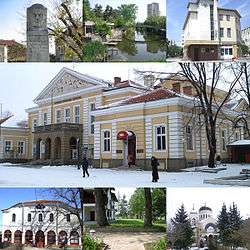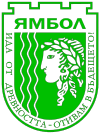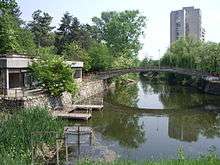Yambol
| Yambol Ямбол | |||
|---|---|---|---|
|
Top left:Statue of George Sheytanov, Top middle:Tundzha River, Top right:Georgi Rakovski Library in Osvobozhdenie Square, Center:Saglasie Community Hall, Bottom left:Yambol Saint George Orthodox Church, Bottom middle:Ormana Park, Bottom right:Saint Nikolay Church of Yambol | |||
| |||
 Yambol Location of Yambol | |||
| Coordinates: 42°29′N 26°30′E / 42.483°N 26.500°ECoordinates: 42°29′N 26°30′E / 42.483°N 26.500°E | |||
| Country | Bulgaria | ||
| Province (Oblast) | Yambol | ||
| Government | |||
| • Mayor | Georgi Slavov (independent) | ||
| Elevation | 114 m (374 ft) | ||
| Population (Census February 2011)[1] | |||
| • City | 74,132 | ||
| • Urban | 111,287 | ||
| Time zone | EET (UTC+2) | ||
| • Summer (DST) | EEST (UTC+3) | ||
| Postal Code | 8600 | ||
| Area code(s) | 046 | ||
| License plate | Y | ||
| Website |
www | ||
Yambol (Bulgarian: Ямбол) is a city in southeastern Bulgaria and administrative centre of Yambol Province. It lies on both banks of the Tundzha river in the historical region of Thrace. It is occasionally spelled Jambol.
The administrative centres of two municipalities are situated in Yambol. One is of the rural area of Tundzha Municipality and the other is of the homonymous Yambol Municipality that embraces the city itself.
Yambol Peak on Livingston Island in the South Shetland Islands, Antarctica is named after Yambol .
History
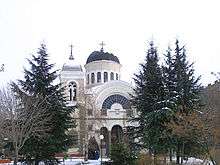

The surrounding area has been inhabited since the Neolithic and was the location of the ancient Thracian royal city of Kabyle. It was founded or refounded by Philip II of Macedon as an Ancient Greek polis.[2][3][4] Yambol was founded by Roman Emperor Diocletian in AD 293; though it was named Diospolis (Διόςπόλις in Greek 'city of Zeus'), the name also reflected the emperor's name. The name later evolved through Diampolis (Διάμπόλις), Hiambouli (Ηιάμβόυλι; in Byzantine chronicles), Dinibouli (دنبلي; Arabic chronicles), Dbilin (Дбилин; in Bulgarian inscriptions), and Diamboli (Диамбоюли) to become Yambol. It was destroyed by the Avars in 583. As the Slavs and Bulgars arrived in the Balkans in the Middle Ages, the fortress was contested by the First Bulgarian Empire and the Eastern Roman Empire, becoming part of Bulgaria in 705 AD during the reign of Khan Tervel. It has been an important Bulgarian center ever since.
The town expanded during the reign of Khan Omurtag of the First Bulgarian Empire and a new fortress was built. Its significance as near the border point made it an important center for both trade and military purposes. During the reign of Boris I and Tsar Simeon the first literary centers were established, mostly as part of the church. Books were imported from Preslav and Ohrid literary schools and they were studied in the town's churches.
During the reign of Tsar Kaloyan, the town again raised in importance, manly due to the ongoing conflict between Bulgaria and the Crusaders. A major battle between Tsar Kaloyan and the crusaders happened in 1204, about 80 kilometers south-west of the town, where Bulgaria defeated the crusaders in the battle of Adrianopole on 14 April 1205.
The predominant religion is Orthodox Christianity with a number of churches being present (among them one of the Holy Trinity, one of St George; the largest one is the cathedral of St Nicholas) erected in 1888; there also exist Eastern Rite Catholic and Protestant religious buildings. During the Ottoman period the town had a very large Muslim population as well. Ottomans conquered it in 1364. It was renamed as "Yanbolu". It was kaza center, which was bounded to successively Çirmen Sanjak (Its center was Edirne) of Rumelia Eyalet (1364–1420), Silistre Sanjak of Rumelia Eyalet (1420-1593),[5] Silistre Sanjak of Silistre Eyalet (1593–1830), İslimye Sanjak of Edirne Vilayet (1830-1878)[6] and İslimye Sanjak of Eastern Rumelia Province before joining to Principality of Bulgaria in 1885. It was occupied again by Ottomans between 25 July 1913 and 10 August 1913 during Second Balkan War.[7]
In modern times Yambol, was a center of the Yambol okolia since 1878, then Yambol okrug since 1948. In 1984 it became part of the newly formed Burgas Oblast where it remained for 10 years. Since the early 1990s Yambol is the center of Yambol oblast.
The city was affected by the turmoils of the early 20th century. I Some Bulgarian refugees from East Thrace, attacked by the Turkish Army in The Destruction of Thracian Bulgarians in 1913, settled in the town. Its Greek population (around 20 families) left during the exchange of populations. It also hosted Bulgarian Macedonian refugees from the failed 1903 Ilinden Uprising. During World War I, Yambol hosted a base for Luftstreitkräfte (Imperial German Army Air Service) zeppelins used for missions in Romania, Russia, Sudan and Malta. The town was chosen by the Germans due to its favorable location and weather conditions.[8]
In the early 21st century, the city became the first one in Bulgaria to use natural gas for domestic purposes.
Population
The population of Yambol during the first decade after the liberation of Bulgaria exceeded 10,000, being 11,241 in 1887.[9] Since then it started growing decade by decade, mostly because of the migrants from the rural areas and the surrounding smaller towns, reaching its peak in the period 1985-1992 exceeding 90,000.[10] After this time, the population has started decreasing rapidly in consequence of the poor economic situation in the Bulgarian provinces during the 1990s that led to a new migration in the direction of the country capital Sofia and abroad. As of February 2011, the city has a population of 74,132 inhabitants, while along with Tundzha Municipality, of which the city is administrative center, the population is 98,287.[1]
Economy
Local industry has declined since the 1990s with many factories closing down. The city is the centre to its thriving agricultural surroundings.
| Yambol | |||||||||||||||
|---|---|---|---|---|---|---|---|---|---|---|---|---|---|---|---|
| Year | 1887 | 1910 | 1934 | 1946 | 1956 | 1965 | 1975 | 1985 | 1992 | 2001 | 2005 | 2009 | 2011 | 2013 | |
| Population | 11,241 | 15,975 | 24,920 | 30,576 | 42,333 | 58,571 | 75,781 | 90,019 | 91,561 | 82,649 | 79,314 | 77,174 | 74,132 | ?? | |
| Highest number 99,339 in 1991 | |||||||||||||||
| Sources: National Statistical Institute,[11][12] „citypopulation.de“,[10] „pop-stat.mashke.org“,[13] Bulgarian Academy of Sciences[9] | |||||||||||||||
Ethnic linguistic and religious composition
According to the latest 2011 census data, the individuals declared their ethnic identity were distributed as follows:[14][15]
- Bulgarians: 59,899 (87.1%)
- Gypsies: 4,263 (6.2%)
- Turks: 3,185 (4.6%)
- Others: 296 (0.4%)
- Indefinable: 1,101 (1.6%)
- Undeclared: 11,718 (8.5%)
Total: 74,132
Climate
| Climate data for Yambol | |||||||||||||
|---|---|---|---|---|---|---|---|---|---|---|---|---|---|
| Month | Jan | Feb | Mar | Apr | May | Jun | Jul | Aug | Sep | Oct | Nov | Dec | Year |
| Average high °C (°F) | 6.5 (43.7) |
8.7 (47.7) |
13.6 (56.5) |
18.4 (65.1) |
24.1 (75.4) |
28.2 (82.8) |
31.1 (88) |
31.2 (88.2) |
25.7 (78.3) |
19.5 (67.1) |
13.7 (56.7) |
7.6 (45.7) |
19.0 (66.2) |
| Daily mean °C (°F) | 3.3 (37.9) |
4.4 (39.9) |
8.4 (47.1) |
13.0 (55.4) |
18.2 (64.8) |
22.5 (72.5) |
25.2 (77.4) |
25.0 (77) |
20.3 (68.5) |
15.0 (59) |
9.6 (49.3) |
4.1 (39.4) |
14.1 (57.4) |
| Average low °C (°F) | 0.0 (32) |
0.2 (32.4) |
3.6 (38.5) |
7.8 (46) |
12.5 (54.5) |
16.8 (62.2) |
19.3 (66.7) |
19.2 (66.6) |
14.8 (58.6) |
10.3 (50.5) |
5.5 (41.9) |
0.7 (33.3) |
9.1 (48.4) |
| Average precipitation mm (inches) | 45.5 (1.791) |
41.6 (1.638) |
32.8 (1.291) |
34.3 (1.35) |
59.8 (2.354) |
50.7 (1.996) |
50.9 (2.004) |
40.7 (1.602) |
70.3 (2.768) |
49.7 (1.957) |
34.6 (1.362) |
58.9 (2.319) |
569.7 (22.429) |
| Mean monthly sunshine hours | 106 | 132 | 181 | 203 | 274 | 303 | 339 | 329 | 242 | 181 | 133 | 101 | 2,525 |
| Source: weatheronline.co.uk[16] | |||||||||||||
Culture
Museums
Yambol houses the Regional History Museum and has a military museum, the Battle Glory Museum.
Arts and entertainment
The city has a Dramatic Theatre, as well as a puppet theatre
Sports
The most popular sport in the city is Basketball with Yambol being a champion in 2002.
Notable natives
- George Papazov, painter
- Georgi Gospodinov, author
- Volen Siderov, journalist and politician
- Radoy Ralin, poet and satirist
- Peter Noikov, educator
- Encho Keryazov, artist de:Encho Keryazov
Twin cities
-
 Târgu-Jiu, Romania
Târgu-Jiu, Romania -
 Villejuif, Paris, France
Villejuif, Paris, France -
 Sieradz, Poland[17] (Since May 2002)
Sieradz, Poland[17] (Since May 2002) -
 Izhevsk, Russia[18] (Since June 1999)
Izhevsk, Russia[18] (Since June 1999) -
 Berdyansk, Ukraine[19] (Since June 2003)
Berdyansk, Ukraine[19] (Since June 2003) -
 Edirne, Turkey[20] (Since October 26, 2005)
Edirne, Turkey[20] (Since October 26, 2005)
Gallery
 Municipality Building, Yambol
Municipality Building, Yambol Garden in front of the Central Post Office
Garden in front of the Central Post Office The Bell Tower of St. George Church, built in 1893
The Bell Tower of St. George Church, built in 1893- The Theater of Yambol
 Church of St George, built in 1737
Church of St George, built in 1737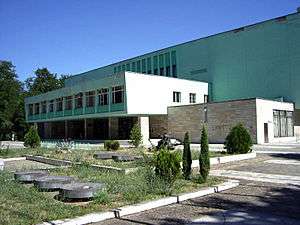 Sport center "Diana", Yambol
Sport center "Diana", Yambol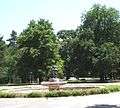 Yambol City Park
Yambol City Park Panoramic view of the city visible from Borovets
Panoramic view of the city visible from Borovets
 Park Ormana
Park Ormana Park Ormana
Park Ormana City park
City park Railway station
Railway station- The Theatre
 Old building, "G.Papazov" str. / "A.Stamboliiski" str.
Old building, "G.Papazov" str. / "A.Stamboliiski" str. "G.Papazov" str. - International Asset Bank
"G.Papazov" str. - International Asset Bank St. Nikola church
St. Nikola church The Roman Catholic church
The Roman Catholic church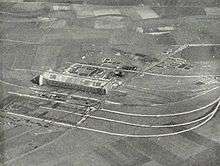 The Bulgarian Air Force Jet Fighter
The Bulgarian Air Force Jet Fighter
References
- 1 2 "National Statistical Institute - Main Towns Census 2011". Retrieved 2013-08-20.
- ↑ An Inventory of Archaic and Classical Poleis: An Investigation Conducted by The Copenhagen Polis Centre for the Danish National Research Foundation by Mogens Herman Hansen,2005,Index - Founded by Phillip II
- ↑ Fol, Aleksandar. The Thracian Royal city of Kabyle. - In: Settlement Life in Ancient Thrace. IIIrd International Symposium "Cabyle", 17–21 May 1993 Jambol. Jambol, 53-55.
- ↑ "The Thracian Royal City of Cabyle" in A. Poulter (ed.), Ancient Bulgaria: Papers presented to the International Symposium on the Ancient History and Archaeology of Bulgaria, University of Nottingham, 1983, pp. 233–238.
- ↑ http://web.firat.edu.tr/sosyalbil/dergi/arsiv/cilt12/sayi1/261-282.pdf
- ↑ http://www.academia.edu/10972841/Do%C4%9Fu_Rumelide_Kay%C4%B1p_K%C3%B6yler._%C4%B0slimye_Sanca%C4%9F%C4%B1nda_1878den_G%C3%BCn%C3%BCm%C3%BCze_G%C3%B6%C3%A7ler_%C4%B0sim_De%C4%9Fi%C5%9Fiklikleri_ve_Harabeler_Lost_Villages_in_Eastern_Rumelia._Migration_Place_Name_Changes_and_Lost_Villages_in_the_Province_of_%C4%B0slimye_Sliven_Southeast_Bulgaria_since_1878_
- ↑ http://www.e-tarih.org/sayfa.php?sfid=815
- ↑ http://bezmer.info/Bezmer_guide_for_US%20military.pdf
- 1 2 Bulgarian Academy of Sciences Archived July 6, 2011, at the Wayback Machine.
- 1 2 "Bulgaria". Citypopulation.de.
- ↑ "National Statistical Institute - Towns population 1956-1992" (PDF). Statlib.nsi.bg:8181. Retrieved 2013-08-20.
- ↑ "Bulgarian National Statistical Institute - towns in 2009". Nis.bg.
- ↑ "pop-stat.mashke.org". Pop-stat.mashke.org. 2011-02-01. Retrieved 2013-08-20.
- ↑ "Population on 01.02.2011 by provinces, municipalities, settlements and age; National Statistical Institute". Retrieved 2013-08-20.
- ↑ "Population by province, municipality, settlement and ethnic identification, by 01.02.2011; Bulgarian National Statistical Institute". Retrieved 2013-08-20.
- ↑ "weatheronline.co.uk: Historical Weather for Yambol, Bulgaria". weatheronline.co.uk. 2012. Retrieved on May 9, 2013.
- ↑ "(in Bulgarian)". Obshtinayambol.org. Retrieved 2013-08-20.
- ↑ "(in Bulgarian)". Obshtinayambol.org. Retrieved 2013-08-20.
- ↑ "in Bulgarian)". Obshtinayambol.org. Retrieved 2013-08-20.
- ↑ http://www.yambol-edirne.org/main.php?lang=en
External links
| Wikimedia Commons has media related to Yambol. |
